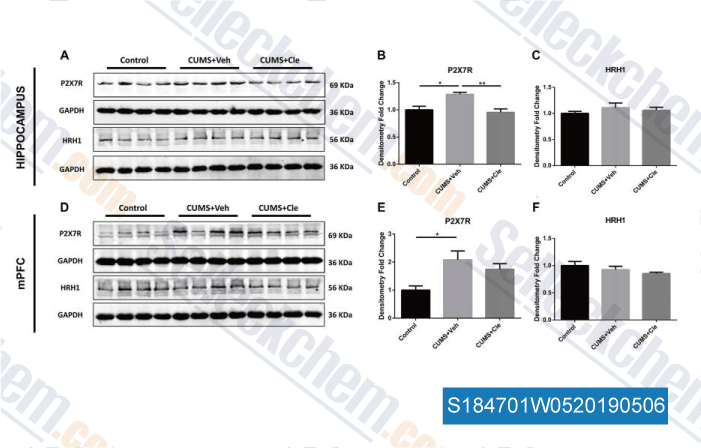|
Toll Free: (877) 796-6397 -- USA and Canada only -- |
Fax: +1-832-582-8590 Orders: +1-832-582-8158 |
Tech Support: +1-832-582-8158 Ext:3 Please provide your Order Number in the email. |
Technical Data
| Formula | C21H26ClNO.C4H4O4 |
||||||
| Molecular Weight | 459.96 | CAS No. | 14976-57-9 | ||||
| Solubility (25°C)* | In vitro | DMSO | 92 mg/mL (200.01 mM) | ||||
| Water | Insoluble | ||||||
| Ethanol | Insoluble | ||||||
| In vivo (Add solvents to the product individually and in order) |
|
||||||
|
* <1 mg/ml means slightly soluble or insoluble. * Please note that Selleck tests the solubility of all compounds in-house, and the actual solubility may differ slightly from published values. This is normal and is due to slight batch-to-batch variations. * Room temperature shipping (Stability testing shows this product can be shipped without any cooling measures.) |
|||||||
Preparing Stock Solutions
Biological Activity
| Description | Clemastine fumarate is a selective histamine H1 receptor antagonist with IC50 of 3 nM. Clemastine stimulates autophagy via mTOR pathway. | ||||
|---|---|---|---|---|---|
| Targets |
|
||||
| In vitro | Clemastine Fumarate inhibits histamine induced rise in [Ca2+]i in HL-60 cells with an IC50 of 3 nM as compared with that of chlorpheniramine or diphenhydramine with IC50 values of 20 nM and 100 nM, respectively. [1] At concentrations of ≥25 μM, Clemastine Fumarate significantly blocks NK and ADCC reactions of lymphocytes against the human erythroleukemia cell line K562 and human B-lymphoblast cell line SB, respectively. [2] Clemastine Fumarate inhibits histamine-induced contraction of guinea pig ileum with an IC50 of 231 nM. [3] Clemastine Fumarate potently inhibits the HERG K+ channel in a concentration-dependent manner in HEK 293 cells stably expressing HERG channels with an IC50 of 12 nM, which can be attenuated by the Y652A or F656A mutation of HERG. [4] Clemastine Fumarate significantly potentiates ATP-induced increase in [Ca2+]i in HEKhP2X7 cells not relying on histamine receptor blockage but on sensitizing P2X7 receptor in a concentration-dependent manner with an EC50 of 10 μM, and increases the IL-1β release from LPS-induced human macrophages. [5] |
||||
| In vivo | Administration of Clemastine Fumarate (5-20 mg/kg) displays significantly inhibitory effect on simultaneously induced zymosan paw oedema and croton oil ear oedema in rats in a dose-dependent manner, with the inhibition of 53.6% and 46.8%, respectively, at the dose of 20 mg/kg, and with ID50 values of 18.0 mg/kg and 20.5 mg/kg, respectively. [6] Clemastine Fumarate treatment strongly reduces innate immune responses to Listeria monocytogenes in mice by interfering with the extracellular signal-regulated kinase (ERK)-mediated production of proinflammatory cytokines such as TNF-α and IL-6 surprisingly not dependent on blocking the histamine H1 receptor, leading to significantly higher mortality. [7] |
Protocol (from reference)
| Kinase Assay: |
|
|---|---|
| Animal Study: |
|
References
|
Customer Product Validation

-
Data from [ , , Front Cell Neurosci, 2018, 12:412 ]

-
Data from [ , , Neurosci Bull, 2015, 31(5):617-25 ]
Selleck's Clemastine fumarate Has Been Cited by 24 Publications
| SGK1 drives hippocampal demyelination and diabetes-associated cognitive dysfunction in mice [ Nat Commun, 2025, 16(1):1709] | PubMed: 39962079 |
| Hypomyelination in autism-associated neuroligin-3 mutant mice impairs parvalbumin interneuron excitability, gamma oscillations, and sensory discrimination [ Nat Commun, 2025, 16(1):6382] | PubMed: 40640134 |
| Clemastine enhances myelin formation in the striatum and medial prefrontal cortex and improves sociability in a neonatal rat hypoxic-ischemic model [ Biomed Pharmacother, 2025, 185:117916] | PubMed: 40058153 |
| Evaluating the effects of pro-myelinating drugs on motor function and myelination in a zebrafish model of genetic leukoencephalopathy [ Neurosci Lett, 2025, 862:138280] | PubMed: 40456507 |
| Pharmacogenomic screening identifies and repurposes leucovorin and dyclonine as pro-oligodendrogenic compounds in brain repair [ Nat Commun, 2024, 15(1):9837] | PubMed: 39537633 |
| The paracaspase MALT1 controls cholesterol homeostasis in glioblastoma stem-like cells through lysosome proteome shaping [ Cell Rep, 2024, 43(1):113631] | PubMed: 38183651 |
| Remyelination-oriented clemastine treatment attenuates neuropathies of optic nerve and retina in glaucoma [ Glia, 2024, 72(9):1555-1571] | PubMed: 38829008 |
| Clemastine-induced enhancement of hippocampal myelination alleviates memory impairment in mice with chronic pain [ Neurobiol Dis, 2024, 190:106375] | PubMed: 38092269 |
| Minimum effective dose of clemastine in a mouse model of preterm white matter injury [ Pediatr Res, 2024, 96(4):933-941] | PubMed: 38942888 |
| Prophylactic clemastine treatment improves influenza A virus-induced cognitive dysfunction in mice [ Brain Behav Immun Health, 2024, 42:100891] | PubMed: 39881819 |
RETURN POLICY
Selleck Chemical’s Unconditional Return Policy ensures a smooth online shopping experience for our customers. If you are in any way unsatisfied with your purchase, you may return any item(s) within 7 days of receiving it. In the event of product quality issues, either protocol related or product related problems, you may return any item(s) within 365 days from the original purchase date. Please follow the instructions below when returning products.
SHIPPING AND STORAGE
Selleck products are transported at room temperature. If you receive the product at room temperature, please rest assured, the Selleck Quality Inspection Department has conducted experiments to verify that the normal temperature placement of one month will not affect the biological activity of powder products. After collecting, please store the product according to the requirements described in the datasheet. Most Selleck products are stable under the recommended conditions.
NOT FOR HUMAN, VETERINARY DIAGNOSTIC OR THERAPEUTIC USE.
